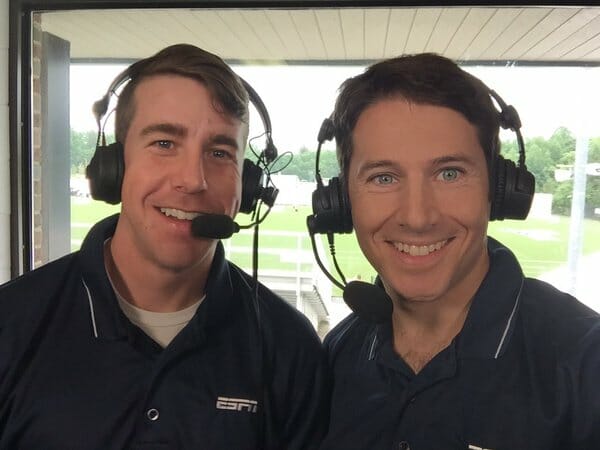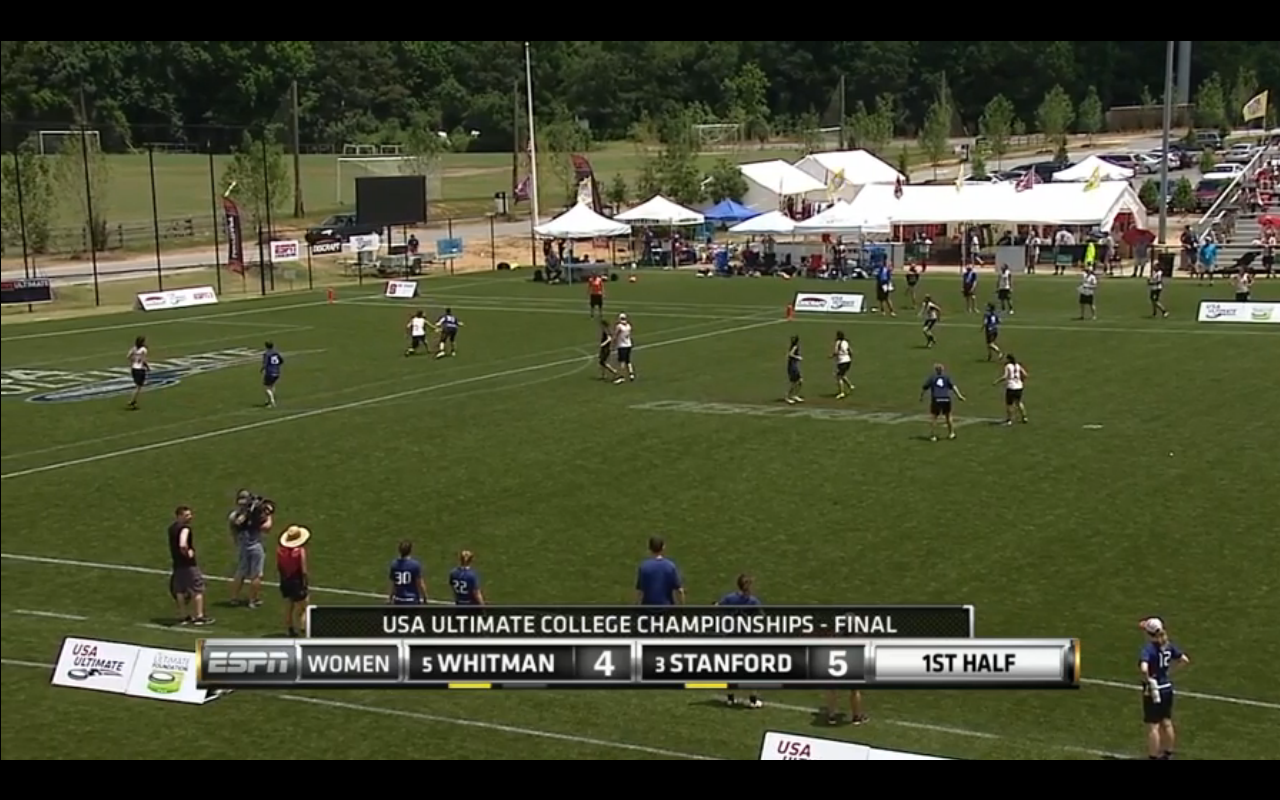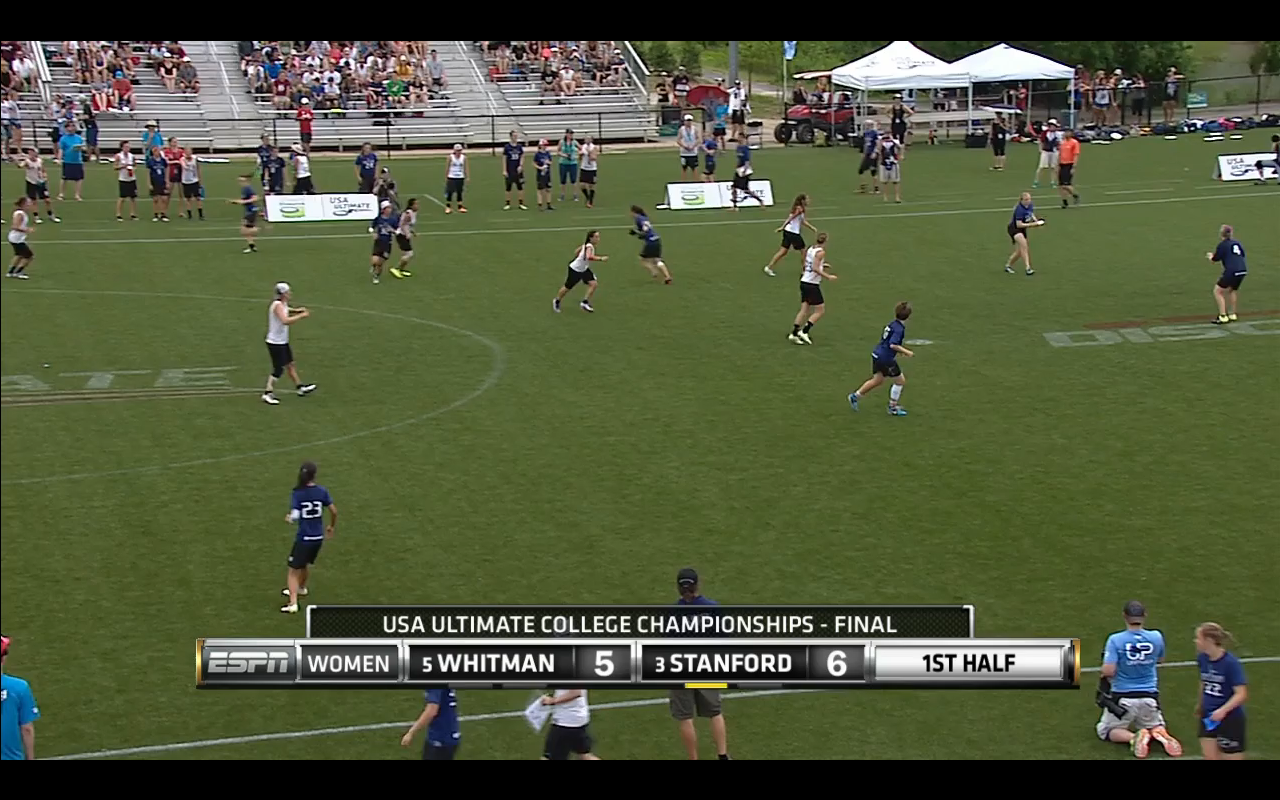June 10, 2016 by Preston Thompson in Analysis, News with 3 comments

The conclusion of 2016 College Championships deserved the best coverage possible from the ESPN3 crew broadcasting the semifinals and finals of the tournament. Five of the six ESPN games were decided by three points or fewer, creating one of the more memorable Nationals environments in recent history.
It’s safe to say expectations were not high for the ESPN3 broadcasts over Memorial Day weekend after years of criticism for poor camera angles, less-than-knowledgable play-by-play announcers, and other production problems. But this year’s broadcasts went above and beyond any that have come before. Let’s review.
Commentary
Throughout ESPN3’s venture into ultimate, Evan Lepler, the “voice of ultimate,” has been there. He brought a professionalism and knowledge of ultimate to the booth that has only been sharpened over time with his work with USA Ultimate and the AUDL. However, he has long been assigned to color commentary alongside various play-by-play commentators, including Mike Couzens, Jim Barbar, and Wayne Randazzo.
In 2016, Lepler got switched to play-by-play and Ian Toner joined up for color. Toner has been a staple of the ultimate media for years, and has plenty of high level playing experience with Johnny Bravo and the U23 Worlds team. “I was really excited to have somebody in the booth with me that really knows ultimate,” said Lepler after the chaos of the weekend had come to an end. “While I have a pretty good base of ultimate knowledge, I certainly don’t have the first hand highest level playing experience like Ian does.”
Past play-by-play announcers had an obvious lack of that ultimate knowledge. While Lepler was able to fill in somewhat for whoever took the seat next to him, it was still patchwork. And Lepler admits that he is more capable as a play by play announcer. “Play by play is my craft,” Lepler said. “It’s what I’ve worked my entire life to hone by listening to all the great broadcasters.”
Lepler having to fill in for some of his partners in previous broadcasts immediately discredited them as a strong source for the game’s narrative. In the 2015 College Nationals broadcast, Jim Barbar was caught a little off guard by a pick call in the FSU-Oregon semifinal. “Isn’t it strange how the cutter gets so wide open [pause] illegally,” Jim Barber noted after the pick.
Dealing with a similar set of stoppages, Toner handled it vastly differently. After a point with multiple stoppages in the second half of the Women’s final, he used it as an opportunity for analysis. “This may not be the most spectator friendly form of the sport, but if you enjoy the X’s and O’s, you can enjoy the chess match here,” Toner said, referring to Stanford’s zone in the championship game. While the informative interaction between the two broadcasters may inform the casual viewer, Toner and Lepler are both informative and analytical in a way that easily beats the former one half of a good press booth.
Camera Angles
One of the biggest complaints about previous ESPN streams was the poor camera angles and production choices. In previous games, the camera has been zoomed in to put the focal point squarely on the thrower at the expense of showing downfield cutting and positioning:
https://gfycat.com/ClassicJollyKinglet
https://gfycat.com/BoilingHollowHare
The need to put the thrower in the center of the frame skews how the game of ultimate is perceived by the viewer. Like soccer, possession should be shown on the third away from the attacking end zone to show the downfield play develop. ESPN got it right this time:


There was some discussion among the media at Nationals about the superior capabilities of the field complex and the ability to set up cameras farther from the field, facilitating better angles. But the 2013 US Open — held in the same location — lets us test whether this was an aberration or simply better production. Take a look at this clip from 2013 on the same field as this year’s College Championships.
https://gfycat.com/InfiniteSecondhandDutchsmoushond
What many fans may not understand about ESPN’s coverage is that while it does have the ESPN banner, the producers are satellite crews from whatever area of the country the tournament is being held in. This means that it is immensely more difficult to build up consistency with how ultimate is produced each time. This year’s production team, however, has now done many events together and the chemistry is starting to show.
While the producers do consider Evan to be the “ultimate expert,” it’s hard for him to control most elements of the broadcast. “It’s hard to walk into the truck and tell a group of people who have been doing TV forever that this is how it has to be,” Lepler said. He would rather stick to a mindset of Patriots head coach Bill Belichick: “Just do your job.”
That said, the camera operators weren’t operating differently this time around. Dave Taska has been the head producer of USA Ultimate events for sometime now, and, according to Lepler, “he will embrace almost any suggestion made by [Marketing and Communications Director] Andy Lee of USA Ultimate.” It’s clear that that cooperation has led to a much better product for fans.
A New Level of Audio
Something that seems natural to most casual sports fans is having a broadcast that makes you feel like you’re watching from the sideline. For ultimate, this is the first time an ESPN3 broadcast had really done that. Sideline mics captured the spirit of the environment (and Auburn player Hank Womble’s glorious trombone from the stands). Mobile cameras with mics gave the viewer inside access to huddles, postgame celebrations, and more, adding something bells and whistles not seen in the past.
“Just having that audio dynamic really took viewers inside the play,” Lepler said. “We’ve done that a little bit in the past, but not with the consistency and effect that we did this weekend.”
What It Means
The quality of the ESPN3 stream doesn’t necessarily help expand the reach of the sport. The best reach comes from the ESPNU cable broadcasts that follow the tournament. Still, with the wider angle and better commentary, there’s an improved chance someone scrolling by would stop and watch for more than a moment. It also, of course, gives diehard fans a better product to admire. The Stanford Superfly zone could not have been enjoyed with previous cameras angles, and John Stubbs’ heroic performance is much better immortalized by the words of Lepler and Toner than what may have been.
Lepler will hopefully be with ultimate for the foreseeable future. With the ESPN deal signed just three years ago, the community was yearning for someone like him, and he is thankful for the opportunity.
“It’s an honor and privilege,” he said. “I’m so grateful for this opportunity and this platform,” Lepler said.
As for what’s next for ultimate streaming, Lepler had more to say about the on-field product than its presentation. “We can show three or four angles of the same replay and still have thirty seconds before the next point,” Lepler said, noting that the long time between points can drag the broadcast. But he also noted that with a new color commentator, the time passes a bit easier. “It’s fun to have time to ask questions of the analyst,” he said. “I’ve enjoyed working with non-ultimate folks in the past, but they weren’t able to ask as knowledgable questions of me as I was able to ask of Ian.”